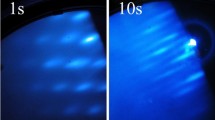Abstract
This paper reviews the current status of the growth of fully doped HgCdTe (MCT) devices by metalorganic vapor phase epitaxy (MOVPE). The current reactor system has been developed to produce 3-inch diameter epitaxial layers compatible with slice-scale processing. The new reactor system has achieved routine epitaxial growth of MCT with good morphology onto both gallium arsenide (GaAs) and GaAs on silicon (Si) wafers that were oriented (2–8°) off (100) orientation. The density of surface defects (so-called “hillocks”), typical of MOVPE growth on such orientation substrates, has been reduced to <5 cm−2 at a sufficient yield to make the production of low cluster defect 2D arrays possible. Alternative growth experiments onto cadmium telluride (CdTe) on Si substrates with (211)B orientation have also been performed to investigate their usefulness for infrared focal plane array (IRFPA) applications. Si substrates give better thermal expansion match to the read out Si circuits (ROIC). The horizontal reactor cell design has a graphite susceptor with a rotating platen capable of using substrates up to 4-inch diameter. Work, however, has concentrated on 3-inch diameter GaAs and GaAs on Si wafers substrates in the reactor, and these reproducibly demonstrated good compositional and thickness uniformity. Cut-off wavelength and thickness uniformity maps showed that there was sufficient uniformity to produce twelve sites of large format 2D arrays (640×512 diodes on 24-µm pitch) per slice. Minority carrier lifetimes in heterostructures is an important parameter and some factors affecting this are discussed, with special emphasis on As-doped material grown under various growth conditions in an attempt to reduce Shockley-Read (S-R) trap densities. New data are presented on trap densities and theoretical fitting of lifetimes in MOVPE material. Fully doped heterostructures have been grown to investigate the device performance in the 3–5 µm medium-wave IR (MWIR) band and 8–12 µm long-wave IR (LWIR). These layers have been fabricated into mesa arrays and then indium-bumped onto Si multiplexers. A summary of the 80-K device results shows that state-of-the-art device performance has been demonstrated in MOVPE-grown device structures.
Similar content being viewed by others
References
J. Tunnicliffe, S.J.C. Irvine, O.D. Dosser, and J.B. Mullin, J. Cryst. Growth 68, 245 (1984).
P. Capper, P.A.C. Whiffin, B.C. Easton, C.D. Maxey, and I. Kenworthy, Mater. Lett. 6, 365 (1988).
C.D. Maxey, C.L. Jones, N.E. Metcalfe, R.A. Catchpole, M.R. Houlton, A.M. White, N.T. Gordon, and C.T. Elliott, J. Electron. Materials 25, 1276 (1996).
C.D. Maxey, M.U. Ahmed, P. Capper, C.L. Jones, N.T. Gordon, and M. White, J. Mater. Sci.: Mater. Electron. 11, 565 (2000).
C.D. Maxey, J.P. Camplin, I.T. Guilfoy, J. Gardner, R.A. Lockett, C.L. Jones, P. Capper, M. Houlton, and N.T. Gordon, J. Electron. Mater. 32, 656 (2003).
L. Hipwood, C.L. Jones, C.D. Maxey, C. Shaw, J. Pilkingon, R. Catchpole, N.T. Gordon, Aerosense SPIE [5074-24], 185 (2003).
N.T. Gordon, J. Electron. Mater., in this issue.
J.P. Camplin, Private communication.
P. Capper, C.D. Maxey, P.A.C. Whiffin, and B.C. Easton, J. Cryst. Growth 96, 519 (1989).
K. Shiginaka, K. Matsushita, L. Sugiura, F. Nakata, K. Hirahara, M. Nagashima, and H. Wada, J. Electron. Mater. 25, 1347 (1996).
K. Maruyama, H. Nishino, T. Okamoto, S. Murakami, T. Saito, Y. Nishijima, M. Uchokoshi, M. Nagahima, and H. Wada, J. Electron. Mater. 25, 1353 (1996).
J.B. Varesi, A.A. Buell, R.E. Bornfrenud, W.A. Radford, J.M. Paterson, K.D. Maranowski, S.M. Johnson, and D.F. King, J. Electron. Mater. 31, 815 (2002).
T.J. de Lyon, J.E. Jensen, M.D. Gorwitz, C.A. Cockrum, S.M. Johnson, and G.M. Venzor, J. Electron. Mater. 28, 705 (1999).
D.J. Hall et al., SPIE Defense & Security Symposium, Infrared Technology and Applications XXX (2004).
P. Mitra, F.C. Case, M.B. Reine, R. Starr, and M.H. Weiler, J. Cryst. Growth 170, 542 (1997).
J. Hails, J. Electron. Materials 35.
P. Fewster, 11th European Workshop on Metalorganic Vapour Phase Epitaxy, Lausanne, Switzerland (2005), pp. 105–110.
P. Capper, editor, II–VI Narrow-Gap Compounds for Optoelectronic and Electromagnetic Applications (Dordrecht, The Netherlands: Chapman and Hall, 1997), p. 115.
Author information
Authors and Affiliations
Rights and permissions
About this article
Cite this article
Maxey, C.D., Fitzmaurice, J.C., Lau, H.W. et al. Current status of large-area MOVPE growth of HgCdTe device heterostructures for infrared focal plane arrays. J. Electron. Mater. 35, 1275–1282 (2006). https://doi.org/10.1007/s11664-006-0254-2
Received:
Accepted:
Issue Date:
DOI: https://doi.org/10.1007/s11664-006-0254-2



